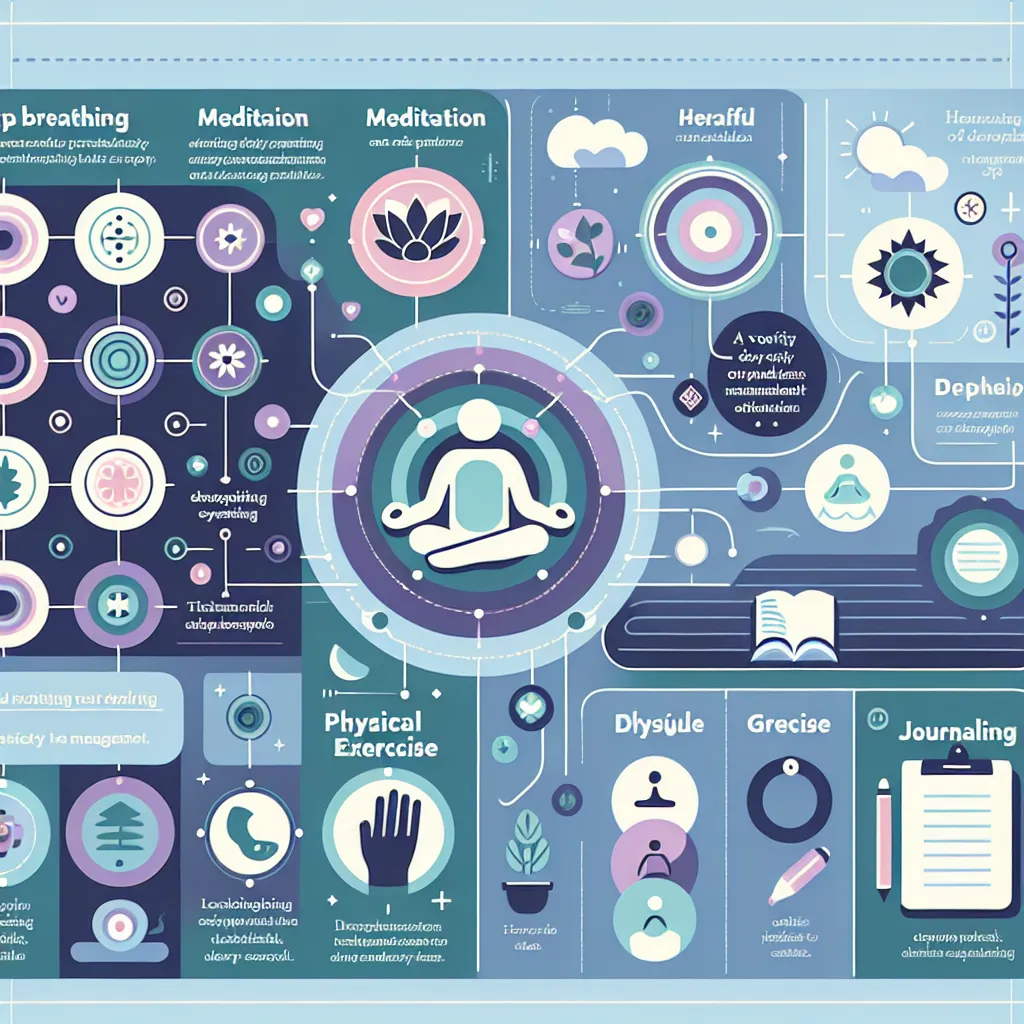The IELTS Reading section is a crucial component of the test, assessing your ability to comprehend complex texts and extract key information. Today, we’ll focus on a topic that has become increasingly relevant in recent years: managing anxiety in uncertain times. This subject has gained prominence due to global events such as the COVID-19 pandemic, economic fluctuations, and geopolitical tensions. Based on the frequency of this theme in recent IELTS exams, it’s likely to appear again in future tests. Let’s dive into a practice passage and questions to help you prepare for this potential topic.
 Anxiety Management Techniques
Anxiety Management Techniques
Practice Passage: Managing Anxiety in Uncertain Times
Text
In an era of unprecedented global challenges, from pandemics to economic instability, the ability to manage anxiety has become an essential life skill. Uncertainty can trigger a range of emotional responses, with anxiety being one of the most common and potentially debilitating. However, there are effective strategies that individuals can employ to maintain their mental well-being during turbulent times.
One of the most powerful tools in managing anxiety is mindfulness. This practice involves focusing on the present moment, acknowledging and accepting one’s thoughts and feelings without judgment. Regular mindfulness meditation has been shown to reduce anxiety symptoms by helping individuals break the cycle of rumination and catastrophic thinking that often accompanies uncertainty.
Another crucial strategy is maintaining a sense of routine and structure. When external circumstances feel chaotic, creating a predictable daily schedule can provide a sense of control and normalcy. This might include setting regular wake-up and bedtimes, scheduling work or study periods, and allocating time for self-care activities such as exercise or hobbies.
Physical exercise is particularly beneficial for anxiety management. Regular physical activity releases endorphins, the body’s natural mood elevators, and can help reduce muscle tension associated with anxiety. Even short bursts of activity, such as a brisk 10-minute walk, can have immediate anxiety-reducing effects.
Social connection, even when physically distanced, is another vital component of anxiety management. Sharing concerns with trusted friends or family members can provide emotional support and perspective. In times when face-to-face interaction is limited, technology can be leveraged to maintain these crucial connections through video calls, messaging apps, or online support groups.
Cognitive restructuring, a technique often used in cognitive-behavioral therapy, can be a powerful tool for managing anxiety in uncertain times. This involves identifying and challenging negative thought patterns and replacing them with more balanced, realistic perspectives. For example, instead of thinking, “Everything is falling apart,” one might reframe it as, “This is a challenging time, but I’ve overcome difficulties before.”
Limiting exposure to anxiety-inducing news and information is also crucial. While staying informed is important, constant exposure to distressing news can exacerbate anxiety. Setting specific times for news consumption and choosing reputable sources can help maintain a balance between being informed and preserving mental health.
Practicing self-compassion is essential when managing anxiety. This involves treating oneself with the same kindness and understanding one would offer a good friend. Recognizing that feeling anxious is a normal human response to uncertainty can help reduce self-criticism and promote emotional resilience.
Finally, seeking professional help when needed is a sign of strength, not weakness. Mental health professionals can provide tailored strategies and support for managing anxiety, particularly when it begins to interfere with daily functioning or quality of life.
In conclusion, while uncertainty is an inevitable part of life, it doesn’t have to lead to debilitating anxiety. By employing a combination of these strategies – mindfulness, routine, exercise, social connection, cognitive restructuring, balanced information consumption, self-compassion, and professional support when necessary – individuals can navigate uncertain times with greater emotional stability and resilience.
Questions
-
Which of the following is NOT mentioned as a strategy for managing anxiety in uncertain times?
A) Mindfulness meditation
B) Regular exercise
C) Financial planning
D) Maintaining social connections -
According to the passage, how does mindfulness help in managing anxiety?
A) By providing a distraction from anxious thoughts
B) By helping break the cycle of rumination and catastrophic thinking
C) By eliminating all negative thoughts
D) By focusing solely on positive experiences -
The passage suggests that creating a daily routine can:
A) Eliminate all sources of uncertainty
B) Guarantee success in managing anxiety
C) Provide a sense of control and normalcy
D) Replace the need for other anxiety management strategies -
What does the text say about the relationship between exercise and anxiety management?
A) Exercise is the most effective method for managing anxiety
B) Only long, intense workouts can reduce anxiety
C) Exercise releases endorphins and can reduce muscle tension
D) Exercise is only effective when combined with medication -
The practice of cognitive restructuring involves:
A) Completely eliminating negative thoughts
B) Ignoring all thoughts related to anxiety
C) Challenging negative thought patterns and replacing them with more balanced perspectives
D) Focusing only on positive thoughts -
According to the passage, what is the recommended approach to consuming news during uncertain times?
A) Avoid all news sources completely
B) Consume news constantly to stay fully informed
C) Set specific times for news consumption and choose reputable sources
D) Only read positive news stories -
The text suggests that seeking professional help for anxiety management is:
A) A last resort when all other strategies fail
B) A sign of weakness
C) Only necessary for severe anxiety disorders
D) A sign of strength and self-awareness -
Which of the following statements best reflects the passage’s view on self-compassion?
A) It is less important than other anxiety management strategies
B) It involves treating oneself with kindness and understanding
C) It is only necessary for individuals with low self-esteem
D) It can replace the need for professional help -
The passage implies that social connection during times of physical distancing:
A) Is impossible to maintain
B) Can be facilitated through technology
C) Is less effective than in-person interactions
D) Should be avoided to prevent anxiety -
What does the conclusion of the passage suggest about managing anxiety in uncertain times?
A) It is impossible to completely eliminate anxiety
B) A single strategy is sufficient for managing anxiety
C) Anxiety management requires a combination of different strategies
D) Uncertainty always leads to debilitating anxiety
Answer Key
-
C) Financial planning
Explanation: The passage does not mention financial planning as a strategy for managing anxiety. It focuses on psychological and lifestyle approaches. -
B) By helping break the cycle of rumination and catastrophic thinking
Explanation: The text states, “Regular mindfulness meditation has been shown to reduce anxiety symptoms by helping individuals break the cycle of rumination and catastrophic thinking that often accompanies uncertainty.” -
C) Provide a sense of control and normalcy
Explanation: The passage mentions, “When external circumstances feel chaotic, creating a predictable daily schedule can provide a sense of control and normalcy.” -
C) Exercise releases endorphins and can reduce muscle tension
Explanation: The text states, “Regular physical activity releases endorphins, the body’s natural mood elevators, and can help reduce muscle tension associated with anxiety.” -
C) Challenging negative thought patterns and replacing them with more balanced perspectives
Explanation: The passage describes cognitive restructuring as “identifying and challenging negative thought patterns and replacing them with more balanced, realistic perspectives.” -
C) Set specific times for news consumption and choose reputable sources
Explanation: The text advises, “Setting specific times for news consumption and choosing reputable sources can help maintain a balance between being informed and preserving mental health.” -
D) A sign of strength and self-awareness
Explanation: The passage states, “Finally, seeking professional help when needed is a sign of strength, not weakness.” -
B) It involves treating oneself with kindness and understanding
Explanation: The text defines self-compassion as “treating oneself with the same kindness and understanding one would offer a good friend.” -
B) Can be facilitated through technology
Explanation: The passage suggests, “In times when face-to-face interaction is limited, technology can be leveraged to maintain these crucial connections through video calls, messaging apps, or online support groups.” -
C) Anxiety management requires a combination of different strategies
Explanation: The conclusion states, “By employing a combination of these strategies – mindfulness, routine, exercise, social connection, cognitive restructuring, balanced information consumption, self-compassion, and professional support when necessary – individuals can navigate uncertain times with greater emotional stability and resilience.”
Common Mistakes to Avoid
When tackling a reading passage like this, be aware of these common pitfalls:
- Overlooking key words: Pay attention to qualifiers like “most,” “least,” “always,” or “never” in both the passage and questions.
- Making assumptions: Base your answers solely on the information provided in the text, not on personal knowledge or opinions.
- Misinterpreting negatives: Be cautious with questions that ask for what is NOT mentioned or is FALSE.
- Falling for distractors: Some answer choices may be partially correct but not the best or most complete answer.
- Rushing through the text: Take time to understand the overall structure and main ideas of the passage before attempting the questions.
Key Vocabulary
- Unprecedented: never done or known before
- Debilitating: making someone very weak and infirm
- Mindfulness: the practice of being aware of your body, mind, and feelings in the present moment
- Rumination: deep or considered thought about something
- Catastrophic thinking: imagining the worst possible outcome in a situation
- Cognitive restructuring: a technique to help identify and dispute irrational or maladaptive thoughts
- Self-compassion: extending compassion to one’s self in instances of perceived inadequacy, failure, or general suffering
Grammar Focus
Pay attention to the use of conditional sentences in discussions about managing anxiety. For example:
“If you practice mindfulness regularly, you may experience reduced anxiety symptoms.”
Structure: If + present simple, will/can/may + base verb
This structure is often used to describe potential outcomes of anxiety management strategies.
Tips for IELTS Reading Success
-
Time management is crucial. Allocate your time wisely across all three sections of the reading test. Learn more about time management skills.
-
Skim the passage quickly before reading in detail. This gives you an overview of the main ideas.
-
Read the questions carefully before searching for answers in the text. This helps you focus on relevant information.
-
Use the headings and subheadings to navigate the text more efficiently.
-
Practice active reading by underlining key words and making brief notes.
-
Don’t spend too much time on one question. If you’re stuck, move on and come back to it later if time permits.
-
Remember that the answers generally appear in the same order as the information in the passage.
-
Be aware of paraphrasing. The correct answer may use different words to express the same idea as the passage.
-
For True/False/Not Given questions, stick strictly to the information in the passage. Don’t make assumptions based on your own knowledge.
-
After completing the test, quickly review your answers if time allows, focusing on any questions you were unsure about.
Remember, managing anxiety during the test itself is also important. If you find yourself feeling overwhelmed, take a deep breath and refocus. Learn more about protecting your mental health during stressful times.
By regularly practicing with passages like this and implementing these strategies, you’ll be well-prepared for the IELTS Reading test, regardless of the topics that appear. Good luck with your preparation!


